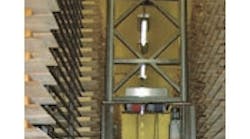In Switzerland, more than 450 different varieties of cheese are produced. The ripening of cheese from the inside to outside is primarily a matter of time and the natural process of curd formation, but it is influenced externally in the maturing room by applying liquid wax — a complex microbial ecosystem based on salt water. Whole cheese is taken off the shelves, turned and brushed with the wax several times each week.
At the Imlig cheese factory at Oberriet, robots assist in the cheese-maturing rooms, doing the heavy work, while maintaining quality and consistency. In addition to the typical stringent requirements of manufacturing and processing foodstuffs, this application demands a special maturing climate of 15°C and 90% humidity. One particular challenge in this environment is ensuring reliable functioning of the maturing system. The biological maturing process in the cheese cannot simply be stopped should something out of the ordinary occur. In the event of even a single day’s breakdown, the damage would be great.
The cheese must be handled without any vibration, despite high speeds, to prevent the cheese from slipping or damage. Depending on the size, there will be three to five whole cheeses lying separately on one wooden board. Every hour, working at full capacity, a robot, traveling on rails between the shelves, removes 200 to 250 such boards from the 6-m-high shelves and puts them back again. Helping the robot with its smooth acceleration and deceleration is the Eco-Drive with Sercos interface from Bosch Rexroth Corp., Hoffman Estates, Ill. Communication via the Sercos interface guarantees rapid and reliable data transfer, along with drive parameterization, in a 5-msec rhythm. The fiber optics used in the control cabinet above the handling module on the robot guarantee reliability with respect to electromagnetic compatibility (EMC).
The cheese-handling robot at the Imlig cheese factory travels between the racks and works through entire rows of shelves independently. It removes the boards on which the whole cheeses are placed and conveys these to the attached processing module. Here the cheeses are pushed off the board onto an arm, which turns them 180° and then places them on so-called baskets for further processing. The cheeses are brushed with liquid cheese wax and simultaneously rotated and subsequently placed back on the board and returned to the shelves. Using a simple operational sequence, the head cheese-maker can specify particular maturing cycles and handling parameters.
